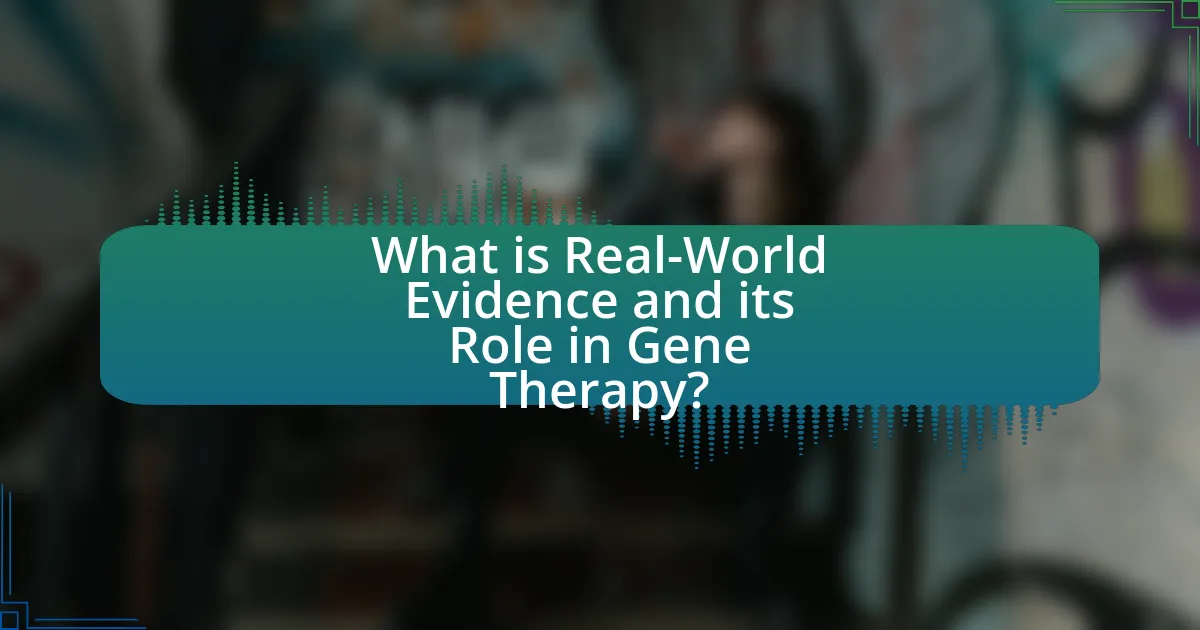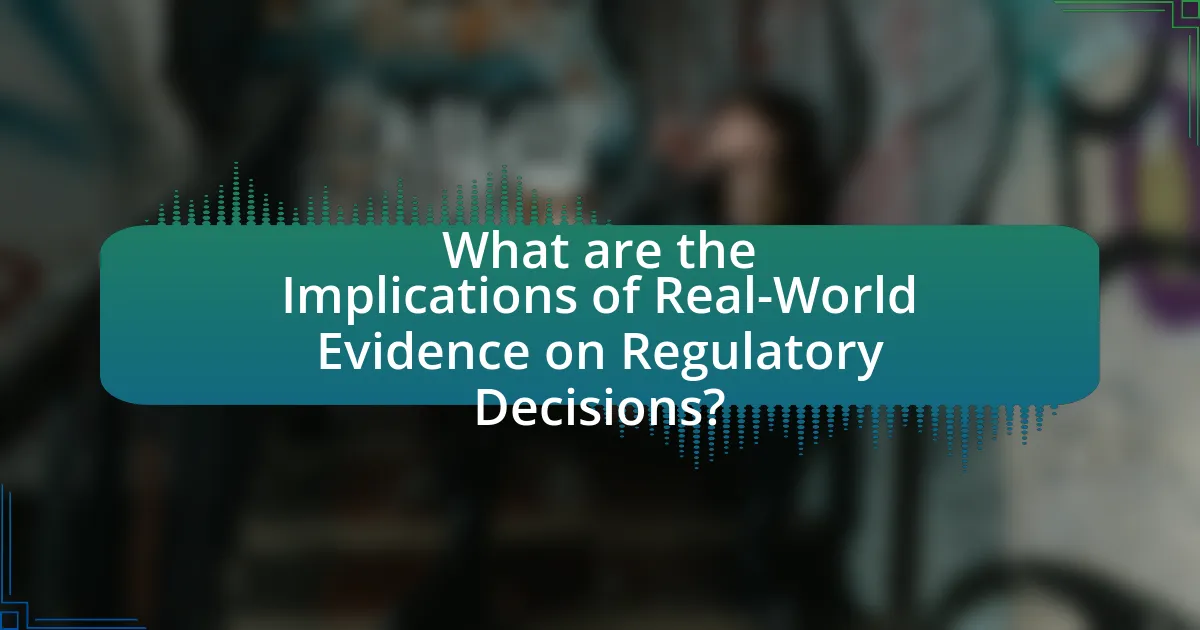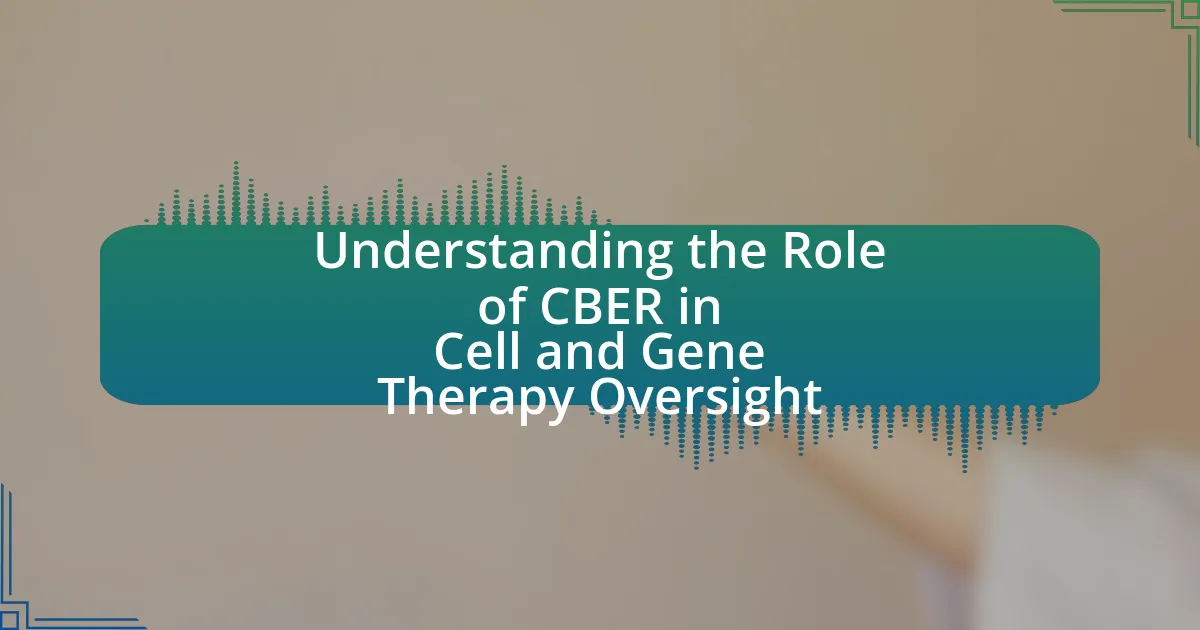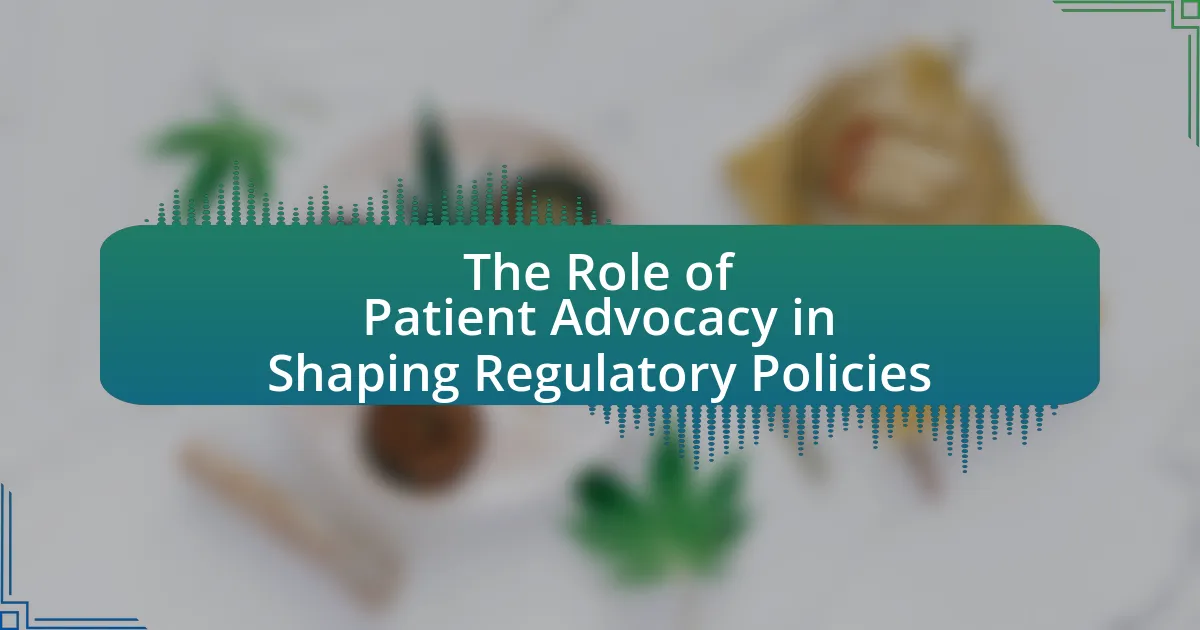Real-World Evidence (RWE) is increasingly recognized for its critical role in influencing regulatory decisions regarding gene therapy. This article explores how RWE, derived from diverse data sources such as electronic health records and patient registries, provides insights into the effectiveness and safety of gene therapies in real-world settings. It discusses the methodologies for collecting and analyzing RWE, the differences between RWE and traditional clinical trial data, and the implications of RWE on regulatory approvals and patient outcomes. Additionally, the article addresses the challenges and limitations associated with RWE, as well as best practices for ensuring its reliability in regulatory contexts.

What is Real-World Evidence and its Role in Gene Therapy?
Real-World Evidence (RWE) refers to the clinical evidence derived from the analysis of real-world data, which includes information on patient health status and the delivery of healthcare routinely collected from various sources. In the context of gene therapy, RWE plays a crucial role by providing insights into the effectiveness and safety of therapies in diverse patient populations outside of controlled clinical trials. For instance, RWE can help identify long-term outcomes, treatment adherence, and the impact of gene therapies on quality of life, thereby informing regulatory decisions and post-marketing surveillance. This evidence is increasingly utilized by regulatory bodies, such as the FDA, to assess the real-world performance of gene therapies, ensuring that they meet safety and efficacy standards in broader patient populations.
How is Real-World Evidence defined in the context of gene therapy?
Real-World Evidence (RWE) in the context of gene therapy is defined as data derived from real-world settings, such as patient registries, electronic health records, and insurance claims, that provide insights into the effectiveness, safety, and value of gene therapies outside of controlled clinical trials. This type of evidence is increasingly recognized for its role in informing regulatory decisions, as it reflects the actual experiences of patients and healthcare providers, thereby complementing traditional clinical trial data. For instance, the FDA has acknowledged the importance of RWE in evaluating gene therapies, as seen in its guidance documents that encourage the use of such evidence to support regulatory submissions and post-marketing surveillance.
What types of data are considered Real-World Evidence?
Real-World Evidence (RWE) encompasses various types of data derived from real-world settings, including electronic health records, claims and billing data, patient registries, and data from wearable devices. These data sources provide insights into patient outcomes, treatment patterns, and healthcare utilization outside of controlled clinical trials. For instance, electronic health records capture comprehensive patient information over time, while claims data reflect actual healthcare services utilized by patients, thus offering a broader understanding of treatment effectiveness and safety in diverse populations.
How does Real-World Evidence differ from traditional clinical trial data?
Real-World Evidence (RWE) differs from traditional clinical trial data primarily in its source and context; RWE is derived from real-world settings, such as electronic health records and patient registries, while traditional clinical trial data is generated through controlled environments with strict protocols. Traditional clinical trials often involve a limited and specific patient population, focusing on efficacy under ideal conditions, whereas RWE encompasses a broader, more diverse population, reflecting actual patient experiences and outcomes in everyday healthcare settings. This distinction is crucial as RWE can provide insights into long-term effectiveness, safety, and the impact of treatments in varied patient demographics, which traditional trials may not fully capture.
Why is Real-World Evidence important for regulatory decisions?
Real-World Evidence (RWE) is important for regulatory decisions because it provides insights into the effectiveness and safety of treatments in everyday clinical practice, beyond controlled clinical trial settings. RWE helps regulators assess how therapies perform in diverse populations and real-world conditions, which can differ significantly from trial environments. For instance, the FDA has utilized RWE to support approvals and label expansions for therapies, demonstrating its role in informing risk-benefit assessments and enhancing post-market surveillance. This evidence can lead to more informed regulatory decisions that reflect actual patient experiences and outcomes.
What impact does Real-World Evidence have on patient outcomes?
Real-World Evidence (RWE) significantly enhances patient outcomes by providing insights into the effectiveness and safety of treatments in everyday clinical settings. RWE allows for the assessment of treatment impacts beyond controlled clinical trials, capturing data from diverse patient populations and real-life scenarios. For instance, studies have shown that RWE can identify variations in treatment responses, leading to more personalized care strategies that improve patient adherence and satisfaction. Additionally, RWE has been instrumental in demonstrating the long-term benefits of gene therapies, influencing regulatory decisions and ensuring that therapies are both effective and safe for broader patient populations.
How does Real-World Evidence support the safety and efficacy of gene therapies?
Real-World Evidence (RWE) supports the safety and efficacy of gene therapies by providing data from actual patient experiences outside of controlled clinical trials. This evidence includes information from patient registries, electronic health records, and post-marketing surveillance, which collectively demonstrate how gene therapies perform in diverse populations and real-world settings. For instance, studies have shown that gene therapies like Zolgensma for spinal muscular atrophy have maintained efficacy and safety profiles consistent with clinical trial results when evaluated in broader patient populations. Additionally, RWE can identify long-term outcomes and rare adverse events that may not be apparent in clinical trials, thereby enhancing the understanding of gene therapy’s impact over time.

How is Real-World Evidence Collected and Analyzed?
Real-World Evidence (RWE) is collected through various methods, including observational studies, patient registries, electronic health records, and claims data analysis. These methods allow researchers to gather data on patient outcomes, treatment patterns, and healthcare utilization in real-world settings, as opposed to controlled clinical trials.
The analysis of RWE involves statistical techniques to assess the effectiveness and safety of interventions, often using comparative effectiveness research to evaluate outcomes across different patient populations. For instance, studies have shown that RWE can provide insights into long-term treatment effects and rare adverse events that may not be captured in traditional clinical trials.
The validity of RWE collection and analysis is supported by its ability to reflect actual patient experiences and outcomes, making it a valuable tool for informing regulatory decisions in gene therapy and other medical fields.
What methodologies are used to gather Real-World Evidence?
Real-World Evidence is gathered using methodologies such as observational studies, patient registries, and real-world data analysis. Observational studies collect data from real-world settings without intervention, allowing researchers to analyze outcomes in diverse populations. Patient registries compile data from individuals with specific conditions over time, providing insights into long-term effects and treatment patterns. Real-world data analysis utilizes electronic health records, claims data, and other health information to assess treatment effectiveness and safety in routine clinical practice. These methodologies are validated by their widespread use in regulatory submissions and their ability to inform clinical guidelines and decision-making processes.
How do observational studies contribute to Real-World Evidence?
Observational studies contribute to Real-World Evidence by providing insights into the effectiveness and safety of interventions in everyday clinical settings. These studies collect data from real patients outside of controlled clinical trials, allowing for a more comprehensive understanding of treatment outcomes across diverse populations. For instance, a systematic review published in the journal “Health Affairs” highlighted that observational studies can reveal long-term effects and rare adverse events that may not be captured in randomized controlled trials. This real-world data is crucial for regulatory bodies, as it informs decision-making regarding the approval and monitoring of gene therapies, ensuring that treatments are both effective and safe for the general population.
What role do registries and databases play in collecting Real-World Evidence?
Registries and databases are crucial in collecting Real-World Evidence (RWE) as they systematically gather and store data on patient outcomes, treatment patterns, and disease progression in real-world settings. These platforms enable researchers and regulatory bodies to analyze large datasets that reflect actual clinical practices, thus providing insights into the effectiveness and safety of gene therapies outside controlled clinical trials. For instance, the European Union’s Orphanet database collects information on rare diseases, facilitating the assessment of gene therapies’ impact on patient populations. This data-driven approach supports regulatory decisions by offering evidence that complements traditional clinical trial results, ensuring that therapies are evaluated based on comprehensive real-world data.
How is Real-World Evidence analyzed for regulatory purposes?
Real-World Evidence (RWE) is analyzed for regulatory purposes through systematic methodologies that assess data from real-world settings, such as electronic health records, insurance claims, and patient registries. Regulatory agencies, like the FDA and EMA, utilize RWE to complement traditional clinical trial data, focusing on its ability to provide insights into treatment effectiveness, safety, and patient outcomes in broader populations. For instance, the FDA’s Framework for Real-World Evidence Program emphasizes the importance of robust study designs, including observational studies and pragmatic trials, to ensure the reliability of findings. This approach is supported by the increasing acceptance of RWE in regulatory submissions, as seen in the approval of therapies based on RWE data, which demonstrates its growing role in informing regulatory decisions in gene therapy and other fields.
What statistical methods are commonly used in the analysis of Real-World Evidence?
Common statistical methods used in the analysis of Real-World Evidence (RWE) include regression analysis, propensity score matching, and survival analysis. Regression analysis helps in understanding relationships between variables, allowing researchers to control for confounding factors. Propensity score matching is utilized to create comparable groups in observational studies, reducing bias in treatment effect estimates. Survival analysis is essential for evaluating time-to-event data, particularly in clinical outcomes. These methods are validated by their widespread application in studies assessing treatment effectiveness and safety in real-world settings, demonstrating their reliability in informing regulatory decisions in gene therapy.
How do regulatory bodies assess the quality of Real-World Evidence?
Regulatory bodies assess the quality of Real-World Evidence (RWE) by evaluating the study design, data sources, and analytical methods used in the evidence generation process. They focus on the robustness of the data, including its relevance, reliability, and validity, to ensure that it can support regulatory decisions. For instance, the U.S. Food and Drug Administration (FDA) emphasizes the importance of well-defined endpoints, appropriate statistical analyses, and the minimization of bias in observational studies. Additionally, regulatory agencies often require that RWE be derived from high-quality databases or registries that capture comprehensive patient information, thereby enhancing the credibility of the findings.

What are the Implications of Real-World Evidence on Regulatory Decisions?
Real-world evidence (RWE) significantly influences regulatory decisions by providing data on the effectiveness and safety of treatments in diverse patient populations outside of controlled clinical trials. Regulatory agencies, such as the FDA and EMA, increasingly utilize RWE to support drug approvals, label expansions, and post-market surveillance, thereby enhancing the understanding of a therapy’s performance in everyday clinical settings. For instance, the FDA’s 2021 guidance on the use of RWE emphasizes its role in demonstrating treatment outcomes and informing benefit-risk assessments, which can expedite access to innovative therapies, including gene therapies. This shift towards incorporating RWE reflects a growing recognition of its value in addressing gaps left by traditional clinical trials, ultimately leading to more informed regulatory decisions that align with real-world patient experiences.
How has Real-World Evidence influenced recent regulatory approvals in gene therapy?
Real-World Evidence (RWE) has significantly influenced recent regulatory approvals in gene therapy by providing data on treatment effectiveness and safety in diverse patient populations. Regulatory bodies, such as the FDA and EMA, have increasingly recognized RWE as a valuable complement to traditional clinical trial data, allowing for a more comprehensive assessment of gene therapies. For instance, the approval of Zolgensma for spinal muscular atrophy was supported by RWE demonstrating its long-term benefits and safety profile in real-world settings, which helped regulators understand its impact beyond controlled trials. This shift towards incorporating RWE reflects a growing trend in regulatory science to ensure that therapies meet the needs of patients in actual clinical practice.
What case studies illustrate the impact of Real-World Evidence on regulatory outcomes?
Case studies demonstrating the impact of Real-World Evidence (RWE) on regulatory outcomes include the approval of Zolgensma for spinal muscular atrophy and the use of RWE in the assessment of CAR-T cell therapies. In the case of Zolgensma, the FDA utilized RWE from patient registries and post-marketing studies to support its efficacy and safety profile, leading to its accelerated approval in 2019. Similarly, for CAR-T therapies like Kymriah and Yescarta, RWE contributed to understanding long-term outcomes and safety in diverse patient populations, influencing their regulatory assessments and labeling. These examples illustrate how RWE can enhance the understanding of treatment effects in real-world settings, thereby shaping regulatory decisions in gene therapy.
How do regulatory agencies incorporate Real-World Evidence into their decision-making processes?
Regulatory agencies incorporate Real-World Evidence (RWE) into their decision-making processes by evaluating data derived from real-world settings, such as electronic health records, insurance claims, and patient registries. This integration allows agencies to assess the effectiveness and safety of therapies in broader populations beyond clinical trials. For instance, the U.S. Food and Drug Administration (FDA) has established frameworks and guidance documents that outline how RWE can support regulatory submissions, including post-market surveillance and label expansions. The FDA’s 2021 guidance on the use of RWE emphasizes the importance of robust methodologies and data quality, ensuring that the evidence is reliable and applicable to regulatory decisions.
What challenges exist in using Real-World Evidence for regulatory decisions?
Challenges in using Real-World Evidence (RWE) for regulatory decisions include data quality, variability in data sources, and the complexity of interpreting results. Data quality is often inconsistent, as RWE can come from diverse sources such as electronic health records, insurance claims, and patient registries, leading to potential biases and inaccuracies. Variability in data sources complicates the ability to generalize findings across different populations and settings. Additionally, the complexity of interpreting RWE results arises from the need to account for confounding factors and the lack of standardized methodologies, which can hinder regulatory agencies’ ability to make informed decisions. These challenges highlight the necessity for rigorous frameworks and guidelines to ensure the reliability and applicability of RWE in regulatory contexts.
What are the limitations of Real-World Evidence in gene therapy?
Real-World Evidence (RWE) in gene therapy has several limitations, primarily related to data quality, generalizability, and regulatory acceptance. The data collected in real-world settings may lack standardization, leading to inconsistencies that can affect the reliability of outcomes. Additionally, RWE often comes from diverse patient populations, which can complicate the interpretation of results and limit the applicability of findings to specific groups. Regulatory bodies may also be hesitant to fully accept RWE due to concerns about the robustness of the evidence compared to traditional clinical trial data, which are typically more controlled and systematic. These limitations highlight the challenges in utilizing RWE effectively in the context of gene therapy.
How can biases in Real-World Evidence affect regulatory outcomes?
Biases in Real-World Evidence can significantly skew regulatory outcomes by leading to inaccurate assessments of treatment efficacy and safety. For instance, if the data collected is predominantly from a specific demographic, it may not accurately represent the broader patient population, resulting in regulatory decisions that favor certain groups over others. A study published in the Journal of the American Medical Association found that biases in observational studies can lead to overestimation of treatment benefits by up to 50%. This misrepresentation can ultimately affect approval processes, post-market surveillance, and the overall trust in regulatory agencies.
What best practices should be followed when utilizing Real-World Evidence in gene therapy?
Best practices for utilizing Real-World Evidence (RWE) in gene therapy include ensuring robust data collection, employing appropriate methodologies, and maintaining regulatory compliance. Robust data collection involves gathering comprehensive patient data from diverse sources, such as electronic health records and patient registries, to capture real-world outcomes effectively. Employing appropriate methodologies means using statistical techniques that account for confounding factors and biases, ensuring the validity of the findings. Maintaining regulatory compliance requires adherence to guidelines set by authorities like the FDA and EMA, which emphasize transparency and the quality of evidence presented. These practices are essential for generating credible RWE that can inform regulatory decisions and support the safe and effective use of gene therapies.
How can stakeholders ensure the reliability of Real-World Evidence?
Stakeholders can ensure the reliability of Real-World Evidence (RWE) by implementing rigorous data collection methods, standardizing protocols, and utilizing validated analytical frameworks. For instance, employing electronic health records and patient registries can enhance data accuracy and completeness. Additionally, adherence to guidelines set by regulatory bodies, such as the FDA’s Framework for RWE, ensures that the evidence generated meets scientific and ethical standards. Furthermore, conducting sensitivity analyses and peer reviews can validate findings, thereby reinforcing the credibility of RWE in influencing regulatory decisions in gene therapy.
What strategies can be employed to enhance the integration of Real-World Evidence in regulatory frameworks?
To enhance the integration of Real-World Evidence (RWE) in regulatory frameworks, regulatory agencies can adopt a multi-faceted approach that includes establishing clear guidelines for RWE use, fostering collaboration between stakeholders, and investing in data infrastructure. Clear guidelines will provide a standardized framework for the collection and analysis of RWE, ensuring that it meets regulatory standards. Collaboration among pharmaceutical companies, healthcare providers, and regulatory bodies can facilitate the sharing of data and best practices, leading to more robust evidence generation. Additionally, investing in data infrastructure, such as electronic health records and patient registries, can improve the quality and accessibility of RWE, enabling regulators to make informed decisions based on comprehensive data sets. These strategies are supported by initiatives like the FDA’s Real-World Evidence Program, which aims to incorporate RWE into regulatory decision-making processes, demonstrating a commitment to utilizing real-world data effectively.




